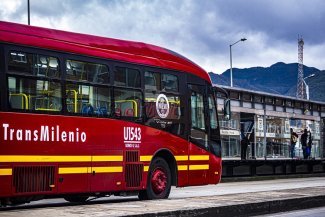
María and Manuel are foster parents, a temporary solution for children left unprotected either because they have been separated from their families or because (like Fatima, in the picture) they find themselves alone in a country that is not their own.
Fatima is playing happily on one corner of the table, trying to piece together a jigsaw puzzle of a blue elephant. Meanwhile, María and Manuel are watching her out of the corner of their eyes: “It doesn’t look like she’s listening to us,” warns Manuel, “but she’s taking everything in right now.”
The three-year-old girl was born in Guinea and arrived in Malaga, Spain on the night of 23 June 2019 after crossing the Mediterranean with a large group of strangers and a woman who claimed to be her aunt. The authorities were unable to confirm the relationship at the time, so they referred the little girl to the child protection service. That is how Fatima came to know María and Manuel.
“I remember it very well. She had little braids and that smile she always has. I asked her if she would like to come with me and she went like this,” says María, visibly moved as she raises her arms. Fatima, immersed in play, does not look up at her, but is very probably taking it all in. She speaks perfect Spanish now.
María and Manuel are foster parents, a temporary solution for children left unprotected either because they have been separated from their families or because, like Fatima, they find themselves alone in a country that is not their own.
According to UNICEF, just over 8,200 children entered Europe through the borders of Greece, Italy, Bulgaria or Spain between January and June 2019. Some 34 per cent of them (almost 2,800 children) were travelling alone or without their parents. Until the authorities locate their parents or closest relatives, these unaccompanied minors remain under the guardianship of the state, which must guarantee all their rights: accommodation, maintenance, education, health and care.
The option of placing them with volunteer families has been around for a long time, especially for the younger ones, but it is still not the most common arrangement. The majority of these children (more than 90 per cent in some countries) are currently placed in reception centres. “It is much easier for the child protection system to rely on dedicated centres than to look for families, to give them help and support. It is, no doubt, the easiest option, but it is not the most beneficial one for the children,” explains Jesús Palacios, professor of developmental psychology and a specialist in foster care.
“One of the things that happens when a child enters an institution is that he or she becomes invisible. They may well be looked after and have their needs covered, but children need a bond. They need someone who is concerned about them, someone who is caring, available and loving. That isn’t possible in residential care centres,” says Palacios. Such needs can only be met in something much more like a family home.
Fostering without expecting anything in return
María and Manuel are a perfectly ordinary, middle class family. They live in a normal flat with two bedrooms and have an average salary. They like to make that clear, as it helps to dispel any preconceived ideas.
“Everyone thinks that families who foster have a big house and a big salary, but we’re low-wage earners,” says María. Aside from that, the couple also have a 7-year-old son and a 14-year-old daughter.
Two years ago, they nonetheless decided to become a foster family. They opted to become an ‘emergency’ foster family, that is, providing urgent foster care for a maximum of six months (other arrangements include temporary care, for two years, and permanent care). They have since welcomed four children into their home. Fatima is the fifth.
“You have to have a great deal of patience and a real desire to do this. It’s daunting at first, because you don’t know what you’re going to find, you don’t know if you’re going to be capable, but I’m very happy,” says María. “Fatima has adjusted to us very well now. She has put on almost four kilos and she won’t leave my side, even for a minute. She says she has two mums.”
There is no specific profile for a foster family. It can be a couple with children or without children, it can be a single person, a person who works or is retired. The only key requirement is a complete understanding of the commitment being undertaken. “Fostering requires a real sense of solidarity,” says Ángeles Ramos, coordinator of Hogar Abierto (Open Household), an association devoted to fostering since 1997.
When selecting foster parents, the association looks at their family dynamics, their parenting methods and, above all, their motivations. “The desire to adopt cannot be the motivation,” Ramos explains, because fostering implies realising that the arrangement will always be temporary. No matter how much Fatima may call them mum and dad, Manuel and María are fully aware that she could go back to her own family at any moment (if that is what is considered best for the child). They have been through it before. “The worst part is saying goodbye,” says Manuel, “Much worse than having to get up in the night, much worse than the tantrums. The bond grows stronger over time. Fostering has its good sides and its bad sides, but the good always wins.
Families wanted
“Foster care is an adequate and often preferable and cost-effective setting for accommodating unaccompanied children,” says the European Asylum Support Office’s Guidance on Reception Conditions for Unaccompanied Children. The centres taking in children do not always have the resources required to provide the individual care these children need. That’s why some run away, end up living on the streets, go missing straight away.
Since 2017, the European Union has been trying to promote family-based care through the FORUM project, a meeting point where experts and associations from eight countries (Austria, Belgium, Italy, United Kingdom, Czech Republic, Spain, Hungary and Slovenia) share their knowledge to help introduce this option in regions less familiar with it. The basic principle is to ensure the children’s best interests are defended and that they grow up in a safe environment.
“A case by case study has to be performed to see what is best for each individual child. There are some who may see foster care as a betrayal of their biological parents. You have to explain to them that it’s not about replacing their family,” says Teresa De Gasperis, FORUM coordinator at the Spanish non-governmental organisation ACCEM.
It is also essential that foster families receive training, economic and emotional support, and that contact is kept with them throughout the whole foster care process. “We have seen how it works in other countries, and it can be done. The challenge is building up a large enough bank of foster families.”
Right now, the Netherlands is leading the way. It is the only European country where there are more volunteer families than children. Its Nidos programme has another distinctive feature, in that it tries to prioritise fostering by families with the same cultural or religious background. The idea is to allow “children to remain connected to their roots”.
This approach is also now being explored in Spain. “It’s true that fostering can be more complicated in a family that does not share the same culture, for example during Ramadan,” says sociologist Carlos Vilches. In 2019, he was commissioned by the government of Navarre to interview 125 families of north African origin to find out their willingness to foster. Only four per cent have shown an interest so far. “The problem is that in most cases these are families living in overcrowded conditions, in shared housing. They need a greater level of financial support.”
Just two out of the 300 migrant children under the government of Navarre’s guardianship are in foster homes. Another five families are in the process of being assessed. “We know it’s going to take time, but the aim is to promote family foster care over residential care. We are looking to the north African community first and then other families,” explains Mikel Gurbindo, assistant director of the family and minors department in the autonomous community.
Then there is the other (even bigger) challenge: finding foster families for older children, adolescents, who in fact constitute the majority.
What about the older children?
Three quarters of the 20,000 unaccompanied minors who applied for asylum in Europe during 2018 were between 16 and 17 years old.
“Providing foster care for adolescents, regardless of their origin, is more complex. You have to be really dedicated. Adolescents constantly challenge you. They need a lot of attention, they need you to get involved in dealing with their problems, they need a lot of time,” explains Elisa García, a criminal law professor specialising in migration, who has also taken in several adolescents from different countries.
“Human beings need to live within a circle of people who love and support them at the same time as setting them some rules and limits. In my experience, it was as hard as bringing up my own children, but I’m glad I did it. It has been a privilege for me,” she says with conviction.
For Palacios, however, not all families are equipped to take on such a challenge. “It has to be made very clear that it is more difficult with adolescents and no amount of goodwill is enough. Their emotional baggage, their needs in terms of food, hygiene, care, are different. Most families are not suitable.” Palacios recommends more specialised families for cases like these, parents that are educators, psychologists, social workers, people that are used to dealing with such complexities.
Another option, if finding parents proves difficult, is to look for aunts and uncles. That is the basis of the Izeba Project in Gipuzkoa. Young migrants in this province enjoy the support of volunteers (aunts and uncles) who get together with them during their free time, a few evenings a week, to go for a walk, to the cinema or take part in a sports activity.
“The idea is to provide these children and teenagers with local connections and caring relationships,” says the head of the project, Kristina Soares. And even if it’s just a few hours, the effects are immediate. “It makes it easier for them to integrate, to meet people from the neighbourhood and helps in their search for training and employment. That is, ultimately, what it is about: helping them to form part of society, never losing sight of the fact that they are vulnerable beings and, regardless of how old they are, never forgetting that, more than migrants, they are still, first and foremost, children.









